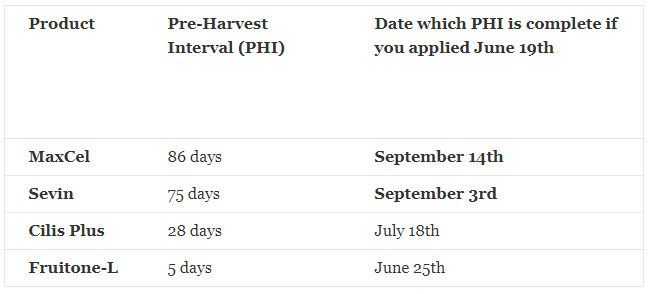From : ONfruit
This post written by: Amanda Green, Tree Fruit Specialist, OMAFRA and Colleen Haskins, Acting Horticulture IPM Specialist, OMAFRA
In this update:
- crop stages
- thinning (chemical and hand)
- irrigation
- diseases (Scab, Fire blight, Powdery Mildew)
- pest activity (Codling Moth, Oblique banded leaf roller, San Jose Scale, Brown Marmorated Stink Bug)
Crop Stages
Fruitlets are increasing in size and are in the cell division stage. At the Simcoe Research station Honeycrisp are at 20mm and Ambrosia are at 24 mm diameter.
Chemical Thinning
Growers are applying their last thinner before fruit gets beyond the size where chemical thinners have little effect. Other growers have wrapped up chemical thinning and may be starting on early hand thinning.
With later chemical thinning, keep in mind the pre-harvest interval (PHI), as a few products PHIs are quite long and could potentially overlap with the harvest window of early varieties.

Hand Thinning
As you finish off chemical thinning and you may be considering starting on hand thinning. Please take note of the REI of Sevin XLR specifically for hand thinning:
14 days for high density, trellised orchard
10 days for traditional, medium to low density, non-trellised orchard.
Irrigation
Most of Western Ontario and Durham have been getting quite dry over the last 30 days before the rain on Monday, receiving 40-60% of normal precipitation (See Agriculture Agri-Food Canada’s Agroclimate Maps). Lambton, Middlesex, Kent and Elgin Counties and parts of Norfolk and Grey County have been especially dry with less than 40% of the normal rainfall in the last 30 days before Monday’s rain. Many growers have mentioned that they have had their irrigation already running. This is a key time for irrigation as it during the time of cell division in the fruitlet which occurs from pollination until 5-6 weeks after bloom (Lakso 2003 and Palmer et al., 2003). Water stress will have a greater impact on size at harvest during the cell division stage than at the cell expansion stage(Lakso 2003). For information on irrigation scheduling see the OMAFRA Irrigation Page and these two blog posts wrote by Rebecca Shortt, Engineer, Water Quantity, OMAFRA, during the dry year of 2016: Irrigation Update and How Long do I Run my Drip Lines
Click here to see more...